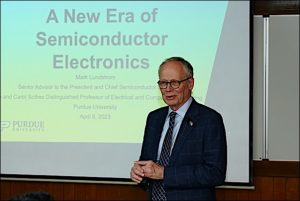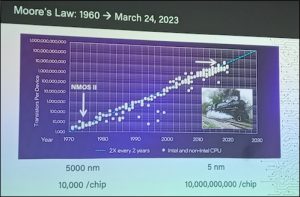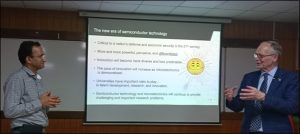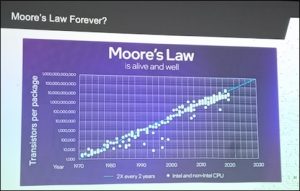
The Nobel Prize in Physics 1956 was awarded jointly to William Bradford Shockley, John Bardeen, and Walter Houser Brattain “for their researches on semiconductors and their discovery of the transistor effect”. These three scientists had invented a device for which they could not find a name! It was John Robinson Pierce, their colleague at Bell Telephone Laboratories, who suggested the name ‘transistor’. Pierce says, “They’d been describing it in descriptive sentences, and a couple of really crazy ideas were put forward.” In an interview, he explains, “The way I provided the name, was to think of what the device did. And at that time, it was supposed to be the dual of the vacuum tube. The vacuum tube had transconductance, so the transistor would have ‘transresistance’. And the name should fit in with the names of other devices, such as varistor and thermistor. And… I suggested the name ‘transistor’.”
From the time that it was invented to replace vacuum tubes, the transistor has come to have a great impact on the electronics industry. In 1965, Gordon Earle Moore predicted that the number of transistors on a single chip would double every year. In the coming decades, this prediction was revised to ‘doubling every two years’ and later ‘doubling every eighteen months’.

Professor Mark Lundstrom (Senior Advisor to the President and Chief Semiconductor Officer, Don and Carol Scifres Distinguished Professor of Electrical and Computer Engineering at Purdue University) pointed out that the end of Moore’s law has been predicted many times. This is because fulfilling Moore’s law is becoming more difficult and expensive. One bottleneck is that the reduction in channel length in a transistor is limited by quantum mechanical tunnelling, which implies a limitation on the number of transistors that can be put on a single chip.
Lundstrom was delivering the ‘India-Purdue Collaborative Lecture’ on 6 April 2023 at the Indian Institute of Science, Bengaluru. This is the ninth lecture in a series of lectures in honour of Professor C N R Rao. In his talk on ‘A new era of semiconductor electronics’, Lundstrom described transistors. For most of his career, Lundstrom has focussed on studying the flow of electrons and holes in semiconductors, and it did not seem right to him that the explanations of how these devices worked were very complex.
Lundstrom’s answer to Carver Mead‘s question “How do we, as a human culture, prepare ourselves and our children for this world in which the knowledge base turns over several times within a single human lifetime?” is that some of the specialised knowledge has to be put back into the framework of common knowledge, and this is as important as the research itself; this is what Lundstrom tries to do. He says, “It is the unification and simplification of knowledge that gives us hope!”

His book ‘Transistors!‘ is an attempt to explain transistors as simply as possible. In his lecture at IISc, Lundstrom explained the working of the transistor in simple terms, and then delved into the related mathematics.
According to Lundstrom, the status of semiconductor electronics today is:

The new era of semiconductor technology:
Coming back to Moore’s law, Lundstrom says it will survive! The electronic system will not be a system on a chip but a system on a package.

In an article in Science, Moore’s Law Forever?, Lundstrom says: “Moore’s law is about lowering cost per function, and molecular electronics might continue the trend without transistors by self-assembling new types of electronics on a Complementary MOS (CMOS) platform. The future of electronics may lie in such heterogeneous systems that complement digital CMOS with new devices and information-processing schemes. For the past 30 years, we have known what to do: make transistors smaller. Progress continues at a breathtaking pace, but transistor scaling is approaching its limit. When that limit is reached, things must change, but that does not mean that Moore’s law has to end.”

The talk ended with an interactive Q&A session where Lundstrom answered questions on the slope of the Moore’s law, how to manage the complexity in such heterogeneous systems, the use of biology in chips, and how an electron weaves its way among other electrons.
